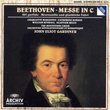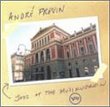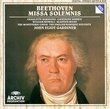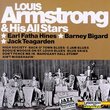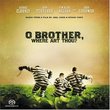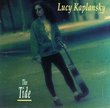| All Artists: Research Composer, Giovanni Antonio Rigatti, Alessandro Grandi, Claudio Monteverdi, Adriano Banchieri, Giacomo Finetti, Pietro Francesco Cavalli, Anonymous, Gregorian Chant, Biagio Marini, Gabrieli Consort, Charles Daniels, Paul McCreesh, Alison Wray, Jonathan Best, Tessa Bonner, Angus Smith, Peter Harvey, Robert Horn, Paula Chateauneuf, Timothy Roberts, Susan Hemington Jones, Fred Jacobs, Celia Harper, Charles Pott, Florian Deuter, Gabrieli Players Title: Venetian Vespers (Monteverdi * Rigatti * Grandi * Cavalli) /Gabrieli Consort & Players * McCreesh Members Wishing: 0 Total Copies: 0 Label: Polygram Records Release Date: 5/11/1993 Genres: Special Interest, Pop, Classical Styles: Vocal Pop, Opera & Classical Vocal, Chamber Music, Historical Periods, Baroque (c.1600-1750), Early Music Number of Discs: 2 SwapaCD Credits: 2 UPC: 028943755221 |
Search - Research Composer, Giovanni Antonio Rigatti, Alessandro Grandi :: Venetian Vespers (Monteverdi * Rigatti * Grandi * Cavalli) /Gabrieli Consort & Players * McCreesh
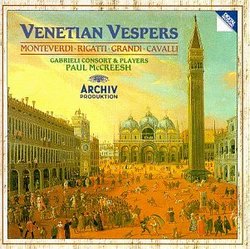 | Research Composer, Giovanni Antonio Rigatti, Alessandro Grandi Venetian Vespers (Monteverdi * Rigatti * Grandi * Cavalli) /Gabrieli Consort & Players * McCreesh Genres: Special Interest, Pop, Classical
Paul McCreesh's second major recording (and second Gramophone Award winner) reconstructs Vespers for the Feast of the Annunciation at San Marco circa 1643, using music by Monteverdi and contemporaries including Cavalli, Gr... more » |
Larger Image |
CD DetailsSynopsis
Amazon.com essential recording Paul McCreesh's second major recording (and second Gramophone Award winner) reconstructs Vespers for the Feast of the Annunciation at San Marco circa 1643, using music by Monteverdi and contemporaries including Cavalli, Grandi, and Rigatti. The music is less dense and lavishly scored than on A Venetian Coronation, but more virtuosic and varied--ranging from Finetti's sweet, languid "O Maria, quæ rapis" for two falsettists and Monteverdi's lively "Laudate Dominum" for solo tenor, to Marini's sensuous sonata for three violins and Monteverdi's spectacular "Lætatus sum" for six singers, two violins, two trombones, and bassoon over a repeated four-note bass. There is so much excitement here that even the opening of "Lætatus sum"--four measures of only the repeating bass--shimmers with energy. --Matthew Westphal Similar CDs
Similarly Requested CDs
|
CD ReviewsAn amazing reproduction of 17th century Vespers Matthew Mendlik | Boston, MA, United States | 12/16/1999 (5 out of 5 stars) "Paul McCreesh and his Gabrieli Consort and Players have put together an entirely captivating re-creation of a Vespers service, the Catholic office of evening prayer, as it might have been performed at St. Mark's in Venice in the early 17th century. From the sacristy bell, to the chants, to the massive and breathtaking polychoral hymns and psalms, McCreesh weaves a tapestry of sound that is simply unparalleled. The Gabrieli Players' violinists play with such Italianate freshness and detail -- down to the last trill -- and the sopranos' voices are so fresh and lively that this CD is simply a must-own for any fan of Early Music. Having just seen the Consort and Players perform in Columbus, OH on 15 Dec. 1999, I can say for sure that this group is simply magical. There are few CDs I would grab on my way out of a burning building -- this is one." A Magnificent Set D. A Wend | Buffalo Grove, IL USA | 10/22/2001 (5 out of 5 stars) "The Vespers that Paul McLeish has reconstructed here are those that might have occurred on March 24, 1643, just one year before the death of Monteverdi whose music figures prominently in this service. Vespers is the principle evening service of the Catholic Church and in Venice the music written for this service was spectacular. At San Marco, the Doge regularly attended Vespers and it was typical that the Pala d'oro, the fantastic piece of Byzantine art, was on display. The music recorded here has great appeal. The Dixit Dominus by Giovanni Antonio Rigatti is very evocative of the warlike nature of Psalm 109 and the four pieces by Monteverdi are among his best works. Of these, the Laetatus sum on Psalm 121 is characterized by highly colorful vocal writing and brilliant scoring which includes a trombone and bassoon, and Monteverdi's Laudate Dominum (Psalm 150) has exquisite writing for the voice. One of the highlights is the motet by Alessandro Grandi O intermerata, which is beautifully sung by Charles Daniels. But I would have to say that I have heard this work by sung with more passion and color by Nigel Rogers (on the recording Venice Preserved). I do recommend comparing the two performances. The performances are truly excellent on this CD and the recording lends a feeling of a large space, so if you close your eyes you could think you have been transported to San Marco. Paul McLeish put a lot of scholarly work into reconstructing this service but it is not a dry example of scholarship but a vivid and brilliant performance. This is excellent music making that I highly recommended and is precisely that excellence that I have come to expect from the Gabrieli Consort. " Some of the most beautiful music ever written S. Jakob | Brooklyn, NY United States | 10/08/1999 (5 out of 5 stars) "One of the few records to put the breathtakingly beautiful music of Alessandro Grandi into the context of that of his teacher and mentor."
|

 Track Listings (18) - Disc #1
Track Listings (18) - Disc #1